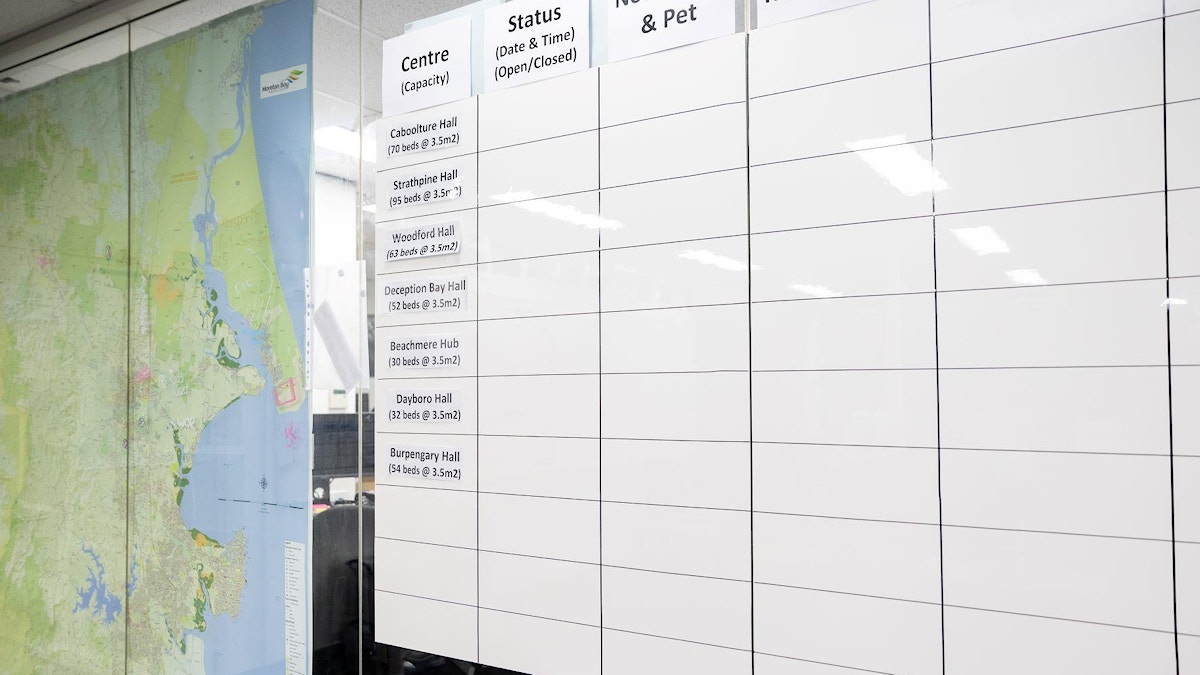
Planning the key to managing weather disasters
Published 4:00am 21 October 2022

 Words by Jodie Powell
Words by Jodie Powell
Weather might be unpredictable, but the Moreton Bay Region’s disaster management team leaves nothing to chance.
Emergency Management and Public Safety manager Carl Peterson Carl Peterson says the team uses an array of data to determine the level of risk when wild weather is forecast.
The 33 flood warning stations across the region installed since the 2011 floods allow for real-time monitoring and feed into information predicting the likelihood and amount of rain provided to Council by the Bureau of Meteorology several times a day.
“There’s been a huge investment in having to get rainfall and river level gauges,” Carl says.
Significant changes

Disaster Management Co-ordinator Chris Barnes says even with the most sophisticated tools and flood mapping available, weather has a reputation for doing its own thing.
|“Micro changes in weather patterns can result in a significant change in the weather in a small space of time,” Chris says.|
“There’s no tool available to be able to predict exactly where weather is going to occur.”
Supplementing information during a disaster are series of checklists, which Chris says are crucial to the smooth co-ordination of disaster operations.
“Check lists are really important because when you’re under stress it’s easy to miss something,” he explains.
“There’s a saying, ‘you don’t rise to the occasion, you sink to your level of training’.
“Check lists act as a handy guide to make sure you’re not missing anything.”
Back to basics

While the team uses technical data and computers to manage disasters, some of the equipment includes old-school boards tracking information such as which sandbag stations are open and the occupancy of evacuation centres.
“Quite often having things on a board allows us to share that situational awareness,” Chris says.
“It’s ever-changing and it allows us to use our screens to for the truly electronic systems,” Carl says.
Chris says with convective weather systems – a collection of thunderstorms that act as a system and form and dissipate very quickly – predicted in the next few days, it’s important for people to stay up to date with the latest information.
Be prepared

One way of doing that is to sign up to MoretonAlert – a free SMS, email and voice alert system that delivers severe weather and bushfire warnings, prescribed burn notifications, potential flash flooding notifications and information about planned dam releases.
Messages include basic information about the type of emergency, the level of threat and recommended action to take.
Reliable sources

“One thing the community can have confidence in is that we listen only to the Bureau of Meteorology,” Chris says.
“They don’t just rely on their own information – they use global models.”
Carl and Chris say the region’s geography leaves us exposed to severe weather at short notice.
“We’re coastal and up against the Hinterland,” Chris says.
“A storm can move from Toowoomba to here in an hour - it’s all a flash-flooding catchment.”
The dome is real

Chris says it’s also the geography that leads to storms often appearing to avoid the Peninsula.
“Locals will talk about the “dome” over the bay and quite often weather goes around us – it’s to do with the terrain, which influences it,” he explains.
Carl says planning for and responding to severe weather is a constant evolution as new data and information becomes available.
Conservative approach
Whereas the team used to swing into action based on advice from the Bureau of Meteorology of a 25 percent probability of the area receiving more than 100–150 millimetres of rainfall in a 24-hour period, it now activates at a 10 percent prediction.
“We used to do everything on the 25 percent then we had the (2015) event where we got the 10 percent,” Carl says
“Now we are ultra-conservative about having this room activated.
|“The trigger for the sandbag stations is now (a forecast) of 100mm (of rain) in 24 hours.”|
Crucial preparation

It’s a strategy that drew praise from the Office of the Inspector General of Emergency Management in its The South East Queensland Rainfall and Flooding February to March 2022 Review Report 1.
“The Moreton Bay Regional Council learned from the 2015 east coast low event that every minute of extra planning and preparation is critical to providing an effective disaster management response,” the report says.
“Floods in the region’s catchment areas can be extremely rapid and serious major flooding can occur where rainfall exceeds 300 millimetres in a 12-hour period.”
The report says Council’s approach ensures the region is well prepared.
“The 10 per cent trigger results in MBRC’s severe weather response plans and LDMG (Local Disaster Management Group) regularly being activated and exercised to Lean Forward and Stand Up, with staff considering this business as usual.
“It also ensures preparations are underway for response if the forecast rainfall totals are exceeded.
“During the 2022 event, the 10 percent trigger enabled early proactive planning and critical information sharing between MBRC and a core group of LDMG and DDMG (District Disaster Management Group) members.”
Early planning
Twice-daily meetings continued during the severe weather and Council’s disaster team moved to 24-hour operation and opened seven evacuation centres early.
“Early planning also allowed (Council) to establish 13 sandbag stations to enable residents access to them before the severe weather.
|“While the duration and impacts of the event across the region tested the planning capabilities of all agencies, use of the early activation trigger meant that MBRC’s preparedness measures were in place 36 hours before the event’s peak.”|
Valuable volunteers

Carl says another important component of the region’s disaster management network are the seven local disaster teams with about 80 volunteers in locations that are prone to isolation.
“The disaster management teams support the community evacuation centres and we provide them with equipment and training.
|“It gives us a chance to get information about what’s happening on the ground.|
“What we hope to do is have many more community groups that are part of the network to be able to support the immediate community.”
Important tools
Further helping the community prepare for natural disasters ranging from flooding to bushfires is a suite of easy-to digest information.
There’s interactive maps of the extent of previous floods in the Council’s Flood Viewer, individual property reports, answers to frequently asked questions and a portal for submitting flood photographs to add to Council’s database and help staff prepare for future severe weather.
Valuable advice
Chris chuckles at some media reports of ghost storms, zombie vortexes, significant rainfall and severe storms that have left many people puzzling over what to believe about weather predictions.
He says signing up for MoretonAlert, learning from Council’s flooding portal and monitoring the Bureau of Meteorology for information are the best tools to avoid scaremongering.
“(Sensationalised reports about severe weather predictions) is one of our biggest challenges – they’re trying to sell newspapers and fill TV time.
|“We quite often get inquiries from people asking ‘what should I do?’|
“It’s all down to individual circumstances. The location of their home has a direct impact on the actions they need to take.
“There’s really good advice as to what people can use as a trigger (to act) and what is their exposure, their vulnerability to flood.”
Related Stories
Top Stories

Aneurysm survivor raises funds for RBWH
Annie Barnett has dedicated her time to raising awareness and funds for aneurysm research after suffering a life-changing brain aneurysm two years ago. Here's the story


Popular Stories

Old nurses' quarters more than just a building
The former nurses’ quarters building at Redcliffe Hospital is a place where memories were made and friendships forged for student nurses who lived there. The building, now known as West Block, is earmarked for demolition in mid-2024. Three nurses who still work at the hospital share their memories

Fighting cancer through art
Mother-of-three Rachel Bernardo will open an art exhibition in Redcliffe next month to help raise awareness of bowel cancer and funding for research. ** FREE TO READ **

Putting safety first for 35 years
Jenny Neate has been going to Bray Park State School for 35 years – and has no plans to stop. ** FREE TO READ **













